*We are a reader-supported website. When you buy through links on our site, we may earn a small affiliate commission at no extra cost to you. Home Media Entertainment does not accept money for reviews.*
It is this time of the year when all new TV models start appearing on the markets across the globe. And with the dust having settled from the initial announcements it is easier to analyze all the new models and their specifications. So after recently looking at what Sony has on their release schedule this year, in our detailed Sony 2023 TV analysis, it is time to look at all the Samsung TVs for 2023 and what new developments to expect compared to 2022.
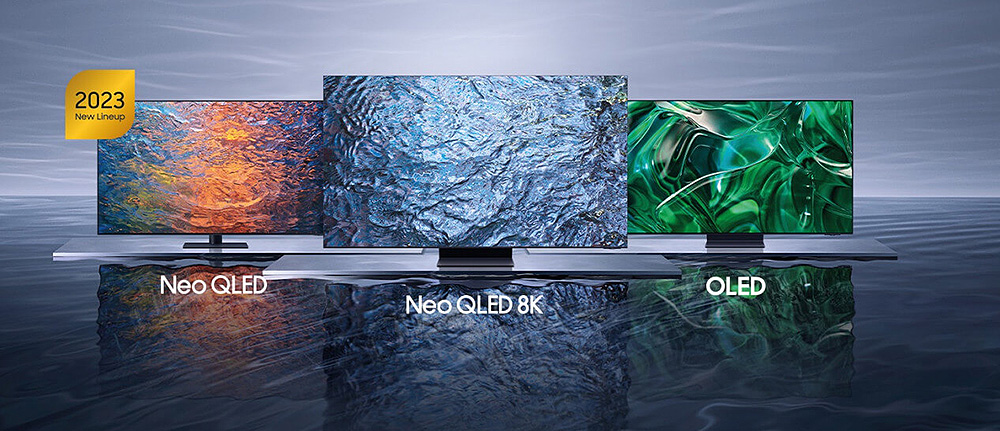
This year it seems that Samsung is determined to expand on their very successful QD-OLED series. And for this reason they added new models and more sizes while making some necessary improvements to this relatively new technology.
Furthermore it seems that Samsung is slowly phasing out TVs with FALD backlights. They are replaced by the more efficient mini LED backlight, something that was to be expected to be honest.
Again Samsung continues to have four distinct series in their entire TV lineup consisting of their top of the line QD-OLED, their premium Neo QLED, their mid-range QLED and finally their budget-friendly Crystal TVs.
Other than the significant improvements in the QD-OLED lineup we do not see any major changes in the other series. Obviously there are some changes here and there between the various models but nothing that really catches our attention. Besides, Samsung’s focus is obviously on expanding their growing QD-OLED market.
Dolby Vision is, as usual, missing with Samsung still refusing to add it. And finally there is no DTS support as Samsung, along with LG, abandoned it a couple of years back.
So let’s go over each series to see what is new, or what is not, this year.
QD-OLED Series
QD-OLED is the crown jewel of Samsung’s TV prowess. And although they had an already very good start last year we believe that 2023 is the time when this technology will really shine.
Samsung has two models on offer in 2023 with the S95C and the S90C. But they have also added new sizes with a 77″ available for the first time. Furthermore Samsung decided to add the One Connect Box which drastically changes the design of their QD-OLED models. Just keep in mind that this is available in the S95C only.
As for their specs it was obvious that the series will get the best of the best. Processing duties are handled by the Neural Quantum Processor 4K while both models officially support 144Hz. For sound we find the Object Tracking Sound system in the S90C while the S95C gets the “Plus” variant.
As per usual both models come with four 48Gbps capable HDMI 2.1 ports with VRR, ALLM and eARC support, making them excellent choices for gaming.
The new Tizen 2023 is available with most features we saw before, along with a few new ones specifically added in 2023.
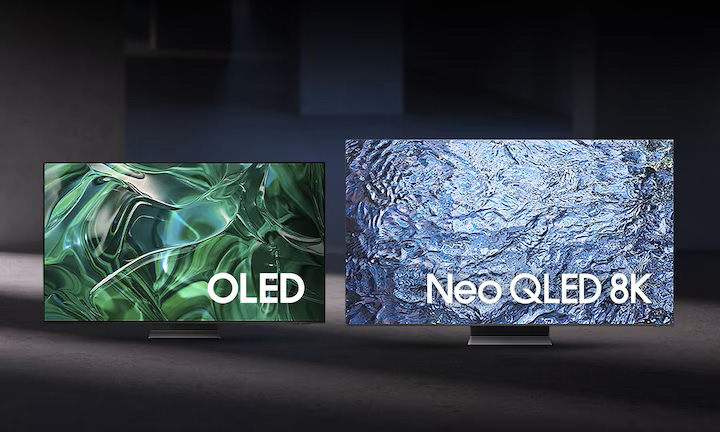
Neo QLED series
Neo QLED used to be the top tier series Samsung had in their arsenal, until QD-OLED took over that position. Now the Neo QLED series is more of a premium offering, and the only one which expands in both 4K and 8K resolutions.
As a result we get three 8K TVs including the QN900C, QN800C and QN700C, and three 4K Neo QLEDS with the QN95C, QN90C and QN85C the ones available.
It seems that for the 2023 edition of the Neo QLED series Samsung will increase the number of dimming zones available. But to be honest from what we have seen so far this may apply only for some of its models. Because a couple of them we have seen come with the same numbers as last year. At least all Neo QLEDs use the more efficient mini LED backlight.
In terms of panels, we get a mixture of different configurations as we find both IPS and VA ones with 144Hz, 120Hz and even 60Hz capabilities. One thing they have in common is that all of them use the Neural Quantum Processor in either its 4K or 8K version. In addition all of them support either 144Hz or 120Hz high frame rate gaming with the exception of the Q700C as that one comes with a 50/60Hz panel.
Another thing that we noticed is that the 8K Neo QLEDs all come with the One Connect Box while the 4K ones do not.

QLED series
QLED will be for one more year their mid-range proposal. The series consists of three models, the Q80C, the Q70C and the Q60C. Although Samsung’s LifeStyle series is supposed to be a separate category some of their models, like The Frame 2023, is actually a QLED model so we have included that in here.
The Q80C is actually the only FALD TV Samsung will be offering this year while all the rest use the less efficient Dual LED system which basically is an Edge LED variant.
Again the QLED series comes with a mixture of specs and technologies but most units, with the exception of the Q60C, support HDMI 2.1 along with 120Hz gaming.
The QLED series is losing a few of the more advanced features we found in the Neo QLED models with one of them being wireless Dolby Atmos.
Finally for sound all of them use the simpler Object Tracking Sound Lite system which uses two real speakers at the bottom of the panel along with two virtual ones at the top corners.
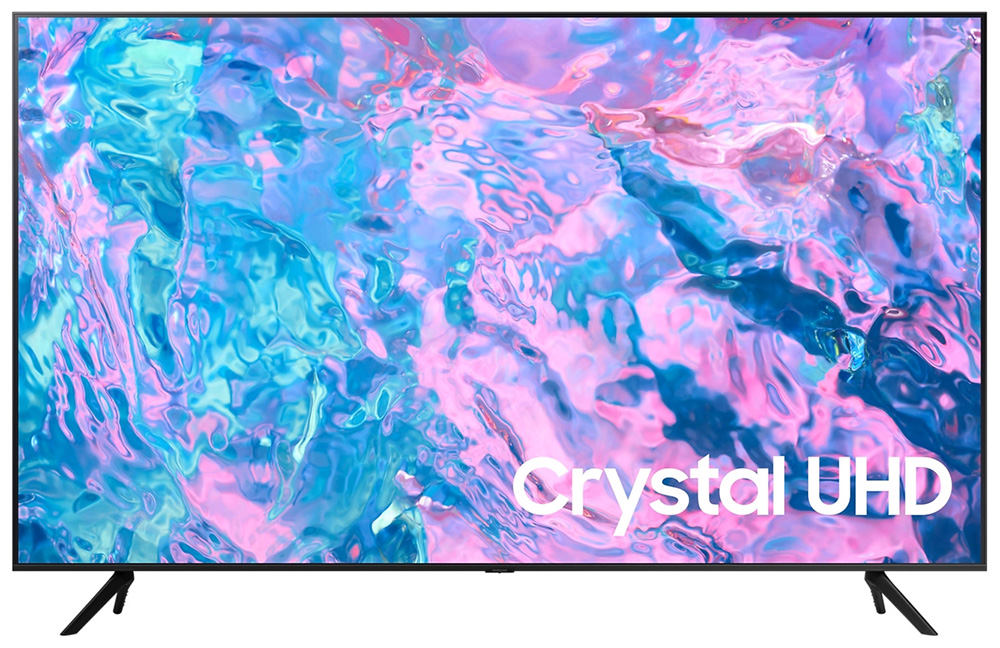
Crystal UHD series
The Crystal UHD 4K TVs remain for one more year Samsung’s cheapest offerings. Keep in mind that there are several models here, more than the ones we mention, but their differences are too small to name them all. Three main models are available, the CU8500, the CU8000 and the CU7000.
The Crystal series drops the Quantum Dot technology that we find in all of the above series and settles for a Crystal panel which results in less color accuracy. Furthermore all units here come with 50/60hz panels and use the less capable Crystal Processor 4K.
Finally we find in all of them the Object Tracking Sound Lite system while their backlight could not be anything else than the usual Dual LED one.
These TVs still use the new Tizen 2023 but with some reductions in its features and capabilities.
New developments for 2023
To be honest other than the QD-OLED technology there are not much new developments this year. We do not know if Samsung decided to focus more in their new lineup but overall it feels like the rest of the models got very minor improvements.
But let’s see everything new happening in 2023.

2nd generation QD-OLED panel
In 2022 Samsung brought for the first time the QD-OLED technology to the market and this year we get an updated version of these panels. Now on its 2nd generation the new QD-OLED panel features a much more efficient blue electroluminescent material that promises higher brightness, higher reliability and lower energy consumption.
We have already seen this new panel in the Samsung S95C and it seems that Samsung’s claims were indeed true.
Tizen 7.0
Samsung continues to improve their proprietary OS as we have reached Tizen 7.0 in 2023. To be honest if you have seen last year’s version then it will be hard for you to spot the differences.
Regarding its overall layout and functionality nothing has changed. There are some minor additions and changes here and there, to make things a bit more efficient, but Tizen remains largely the same OS we saw in 2022.
But let’s see the new additions for this year.
Game Bar 3.0
The Game Bar is not a new feature but Samsung decided to make a few changes, or rather improvements if you like, this year.
This is an on-screen menu that lets you make real-time adjustments to screen ratio, input lag check, FPS, HDR, wireless headset settings and more. This can be a really handy feature to gamers as you don’t have to mess with menus every time you want to check on a specific setting. With this quick feature you have everything in front of you with the click of a button.
The new Game Bar 3.0 has a couple 2023 features that were not available before. This is MiniMap sharing and Virtual Aim Point for gaming.

Everything Else New
But that’s not all. Samsung added Matter Thread and Philips Hue Sync app support in Tizen while they also included a smart calibration function that works in combination to your smartphone.
Closing
It’s been 17 years that Samsung holds the title of the No 1 TV manufacturer and seems determined to keep it. And this year the focus is surely on growing their QD-OLED business with new models and new sizes.
Overall although we are impressed with their updated QD-OLED technology we feel that they have slightly neglected the rest of their lineup. They surely made a few changes here and there but nothing major to up the value of their TVs compared to last year.
Keep in mind that prices have gone up across the entire TV industry and you would expect Samsung to offer something in return to lure new consumers. But all the other series, except the QD-OLED one, do nothing to convince the market that they deserved the price increase.
Surely Samsung relies a lot on their brand prowess, but is this enough to keep them at the top? Especially with some aggressive pricing from other brands like Hisense? Only time will tell.
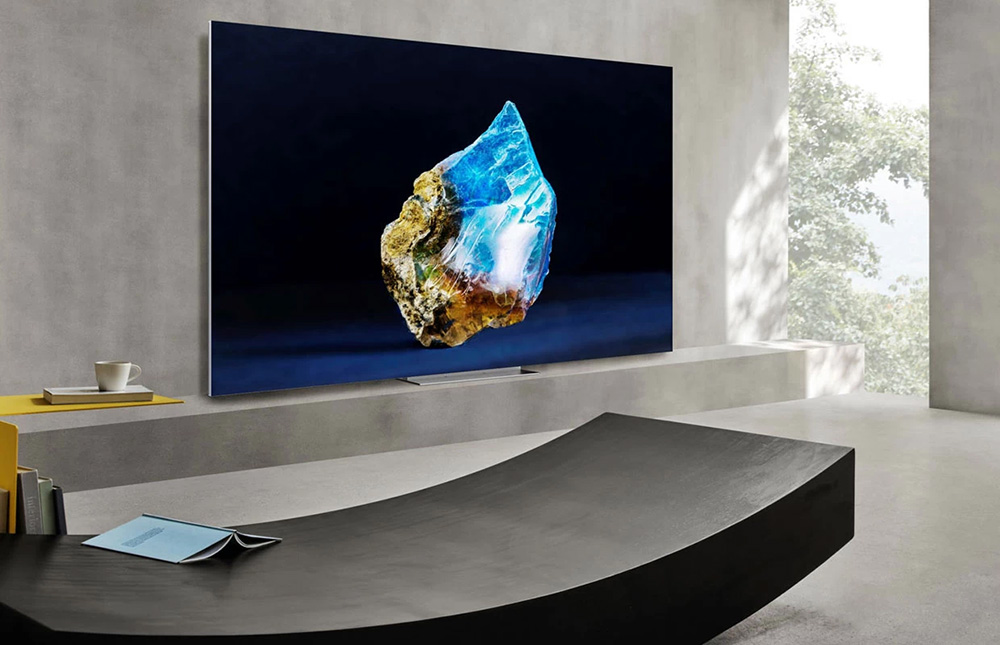
As always to keep things as simple as possible we have added comparison tables at the beginning and end of this guide in order for you to have a way of comparing between the most significant features of each new TV directly.
Before closing this part we should mention that you can check our New Product Lineups section for more reviews and articles which we will update as we manage to get our hands on these new releases.
So without further delay let’s analyze each model separately.
Samsung S95C (4K QD-OLED TV)

Type : Flat
The Samsung S95C replaces the 2022 S95B and comes with a 2nd generation QD-OLED panel that is capable of higher brightness, better efficiency and lower risk of burn-in.
All other specs are more or less the standard you should expect from such a top tier release with Samsung’s best Neural Quantum Processor 4K, Object Tracking Sound+ for sound and support for 144Hz.
The S95C comes with Samsung’s One Connect Box that includes all electronics together in order to create a more slim profile for the panel.
You can read our full analysis on this TV in our Samsung S95C review we did recently.
Specifications
- 4K resolution (3,840 x 2,160)
- QD-OLED display technology
- 144Hz frequency
- Neural Quantum Processor 4K
- HDR10, HDR10+ Adaptive, HLG support
- OTS+ / 4.2.2 channels 70W
- Dolby Atmos / Wireless Dolby Atmos support
- Ultra Viewing Angle, Game Bar 3.0, Filmmaker Mode, HGiG mode
- 4 x HDMI 2.1
- ARC / eARC, VRR, FreeSync, G-SYNC, ALLM, HFR
- WiFi5, Bluetooth 5.2
- Tizen Smart Platform 2023
- One Connect Box, One Remote
Samsung S90C (4K QD-OLED TV)

Type : Flat
The Samsung S90C is a more affordable QD-OLED as Samsung tries to expand the QD-OLED lineup a little bit.
The only major differences is that this TV is slightly less bright than the S95C, uses a less capable audio system and does not use the One Connect Box. All other specs are the same.
You can read our full analysis and testing in our dedicated Samsung S90C review.
Specifications
- 4K resolution (3,840 x 2,160)
- QD-OLED display technology
- 144Hz frequency
- Neural Quantum Processor 4K
- HDR10, HDR10+ Adaptive, HLG support
- OTS Lite / 2.1 channels 40W
- Dolby Atmos / Wireless Dolby Atmos support
- Ultra Viewing Angle, Game Bar 3.0, Filmmaker Mode, HGiG mode
- 4 x HDMI 2.1
- ARC / eARC, VRR, FreeSync, G-SYNC, ALLM, HFR
- WiFi5, Bluetooth 5.2
- Tizen Smart Platform 2023
- One Remote
Samsung QN900C (8K Neo QLED TV)
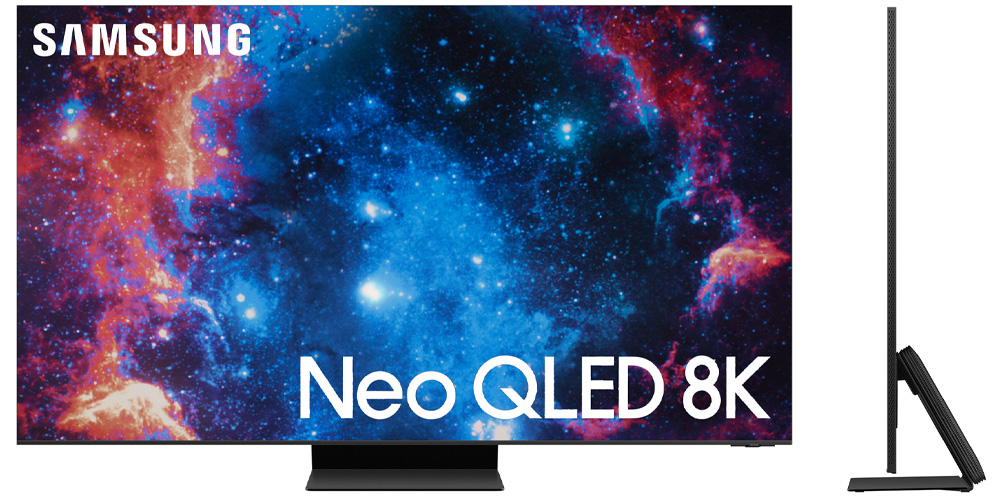
Type : Flat
Samsung is not giving up on their 8K models yet although it’s been a few years on the market without any meaningful content to take advantage of their capabilities.
The QN900C replaces the 2022 QN900B with minor differences and upgrades.
Specifications
- 8K resolution (7,680 x 4,320)
- Neo QLED display technology
- VA panel with 144Hz frequency
- miniLED FALD Backlight system
- Neural Quantum Processor 8K
- HDR10, HDR10+ Adaptive, HLG support
- OTS Pro / 6.2.4 channels 90W
- Dolby Atmos / Wireless Dolby Atmos support
- Game Bar 3.0, Filmmaker Mode, HGiG mode
- 4 x HDMI 2.1
- ARC / eARC, VRR, FreeSync, G-SYNC, ALLM, HFR
- WiFi6E, Bluetooth 5.2
- Tizen Smart Platform 2023
- One Connect Box, One Remote
Samsung QN800C (8K Neo QLED TV)
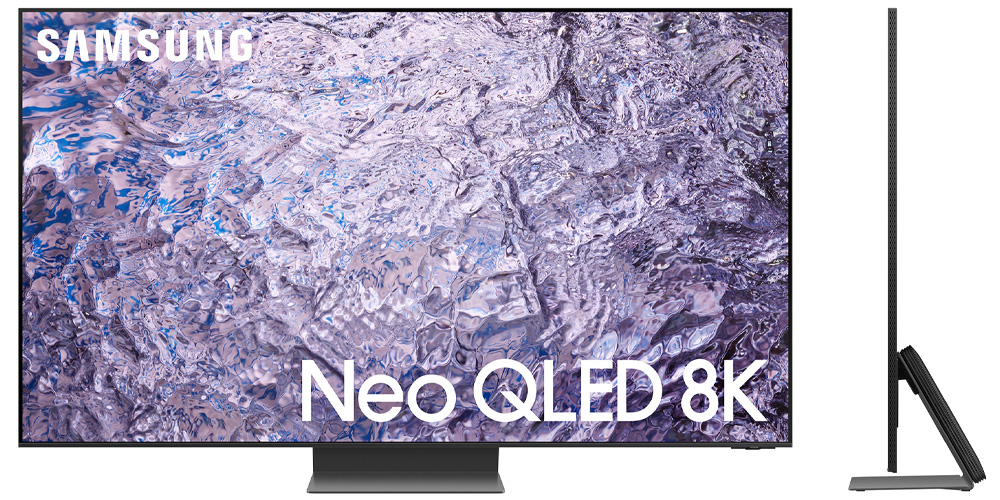
Type : Flat
The QN800C is a slightly more affordable 8K offering. There are two notable differences from the top tier QN900C and these are the 120Hz support instead of 144Hz and the less capable OTS+ audio system.
Specifications
- 8K resolution (7,680 x 4,320)
- Neo QLED display technology
- VA panel with 100/120Hz frequency
- miniLED FALD Backlight system
- Neural Quantum Processor 8K
- HDR10, HDR10+ Adaptive, HLG support
- OTS+ / 4.2.2 channels 70W
- Dolby Atmos / Wireless Dolby Atmos support
- Game Bar 3.0, Filmmaker Mode, HGiG mode
- 4 x HDMI 2.1
- ARC / eARC, VRR, FreeSync, G-SYNC, ALLM, HFR
- WiFi6E, Bluetooth 5.2
- Tizen Smart Platform 2023
- One Connect Box, One Remote
Samsung QN700C (8K Neo QLED TV)
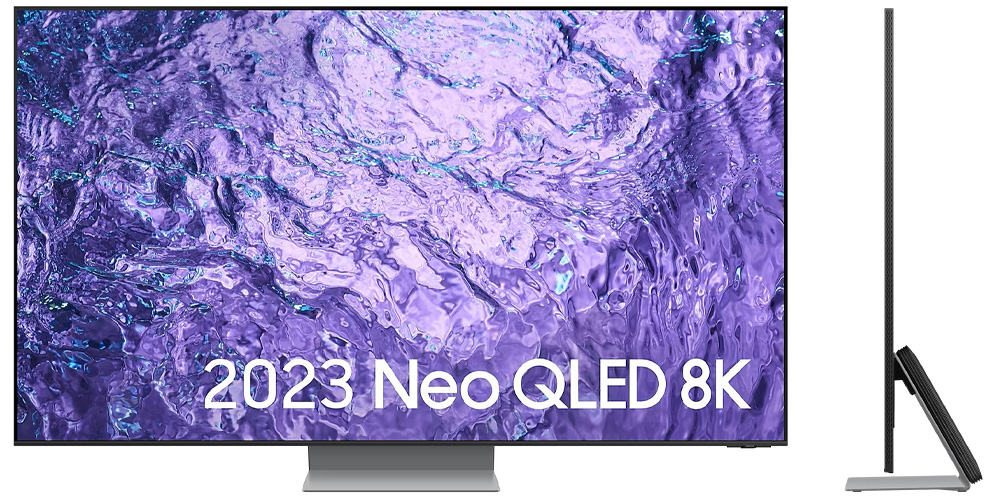
Type : Flat
We are still in 8K territory here but the QN700C seems to have some major differences compared to the other two 8K models.
First we find a less capable processor with the Neural Quantum Processor 4K Lite. There is a simpler audio system with the OTS Lite. And lastly it loses support for HFR as it comes only with a 50/60Hz panel. Its WiFi is also downgraded to WiFi5.
Specifications
- 8K resolution (7,680 x 4,320)
- Neo QLED display technology
- VA panel with 50/60Hz frequency
- miniLED FALD Backlight system
- Neural Quantum Processor 8K Lite
- HDR10, HDR10+ Adaptive, HLG support
- OTS Lite / 4.2 channels 60W
- Dolby Atmos / Wireless Dolby Atmos support
- Game Bar 3.0, Filmmaker Mode, HGiG mode
- 4 x HDMI 2.1
- ARC / eARC, VRR, FreeSync, G-SYNC, ALLM
- WiFi5, Bluetooth 5.2
- Tizen Smart Platform 2023
- One Connect Box, One Remote
Samsung QN95C (4K Neo QLED TV)
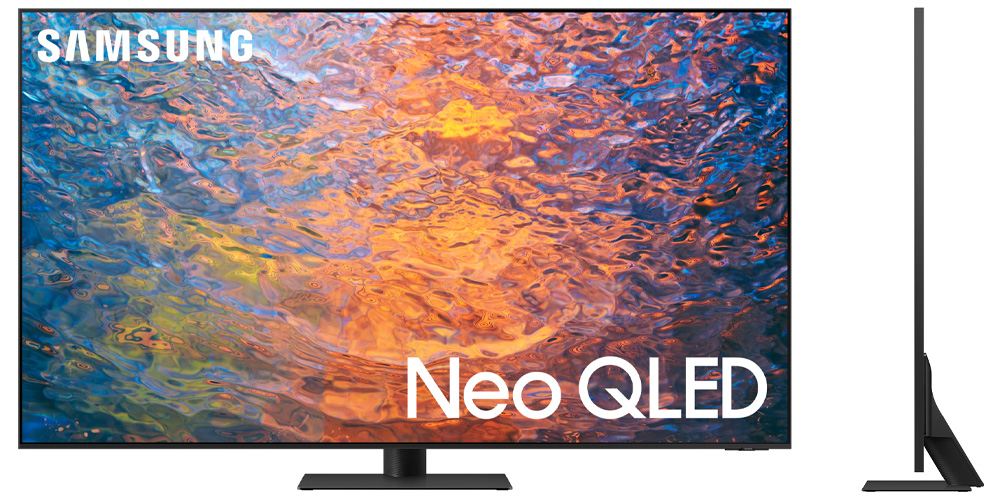
Type : Flat
The QN95C is Samsung’s top 4K LED LCD TV for 2023. And it comes with all the bells and whistles you would expect from a premium model like this.
You can read all about this model in our detailed Samsung QN95C review.
Specifications
- 4K resolution (3,840 x 2,160)
- Neo QLED display technology
- VA panel with 144Hz frequency
- miniLED FALD Backlight system
- Neural Quantum Processor 4K
- HDR10, HDR10+ Adaptive, HLG support
- OTS+ / 4.2.2 channels 70W
- Dolby Atmos / Wireless Dolby Atmos support
- Game Bar 3.0, Filmmaker Mode, HGiG mode
- 4 x HDMI 2.1
- ARC / eARC, VRR, FreeSync, G-SYNC, ALLM, HFR
- WiFi5, Bluetooth 5.2
- Tizen Smart Platform 2023
- One Remote
Samsung QN90C (4K Neo QLED TV)
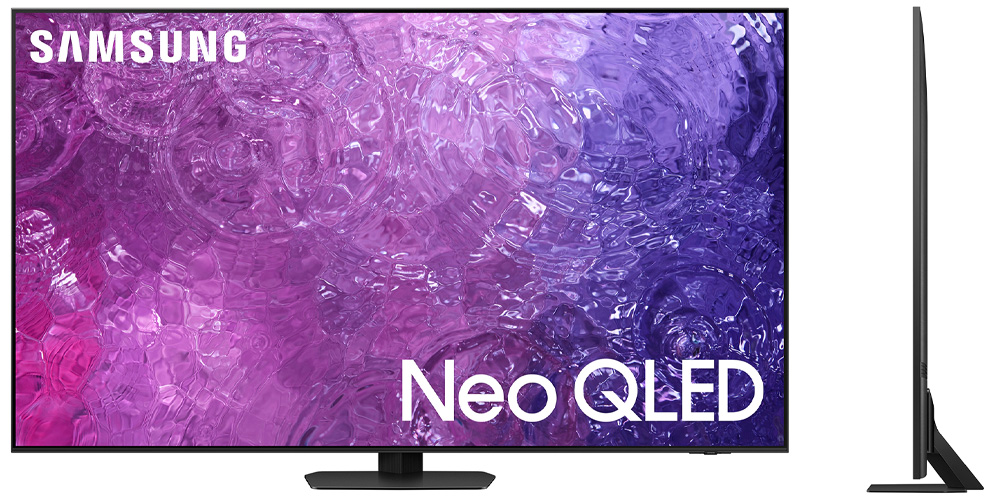
Type : Flat
The QN90C is a strange one. It is very similar to the QN95C but with one notable difference. While the 43″ and 50″ sizes still come with VA panels and 144Hz support all other sizes switch to IPS panels with 100/120Hz capabilities. All other specs are entirely the same.
You can read our full analysis and testing of this model by clicking on our Samsung QN90C review.
Specifications
- 4K resolution (3,840 x 2,160)
- Neo QLED display technology
- IPS – 100/120Hz (43″,50″ VA – 144Hz)
- miniLED FALD Backlight system
- Neural Quantum Processor 4K
- HDR10, HDR10+ Adaptive, HLG support
- OTS+ / 4.2.2 channels 70W
- Dolby Atmos / Wireless Dolby Atmos support
- Game Bar 3.0, Filmmaker Mode, HGiG mode
- 4 x HDMI 2.1
- ARC / eARC, VRR, FreeSync, G-SYNC, ALLM, HFR
- WiFi5, Bluetooth 5.2
- Tizen Smart Platform 2023
- One Remote
Samsung QN85C (4K Neo QLED TV)

Type : Flat
The QN85C is the most affordable mini LED Samsung has this year. Compared to the above it uses IPS panels with 100/120Hz capabilities across all sizes and uses the less capable OTS audio system.
You can read our detailed analysis of this TV in our Samsung QN85C review.
Specifications
- 4K resolution (3,840 x 2,160)
- Neo QLED display technology
- IPS panel with 100/120Hz frequency
- miniLED FALD Backlight system
- Neural Quantum Processor 4K
- HDR10, HDR10+ Adaptive, HLG support
- OTS / 2.2.2 channels 60W
- Dolby Atmos / Wireless Dolby Atmos support
- Game Bar 3.0, Filmmaker Mode, HGiG mode
- 4 x HDMI 2.1
- ARC / eARC, VRR, FreeSync, G-SYNC, ALLM, HFR
- WiFi5, Bluetooth 5.2
- Tizen Smart Platform 2023
- One Remote
Samsung Q80C (4K QLED TV)
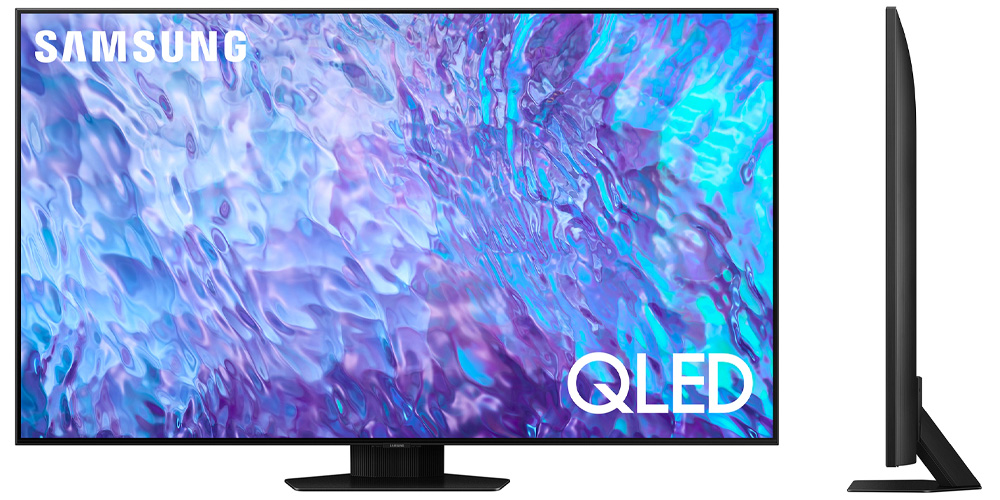
Type : Flat
With the mini FALD backlight dominating the market the FALD TVs are slowly phasing out. And this is evident by this year’s lineup as the Samsung Q80C is the only FALD unit on offer in 2023.
Other than that it still retains a lot of the more advanced features we find in the more premium units.
You can read more about this TV in our thorough Samsung Q80C review.
Specifications
- 4K resolution (3,840 x 2,160)
- QLED display technology
- VA panel with 100/120Hz frequency (50″ – 50/60Hz)
- FALD Backlight system
- Neural Quantum Processor 4K
- HDR10, HDR10+ Adaptive, HLG support
- OTS Lite / 2.2 channels 40W
- Dolby Atmos support
- Game Bar 3.0, Filmmaker Mode, HGiG mode
- 4 x HDMI 2.1
- ARC / eARC, VRR, FreeSync, G-SYNC, ALLM, HFR
- WiFi5, Bluetooth 5.2
- Tizen Smart Platform 2023
- One Remote
Samsung Q70C (4K QLED TV)
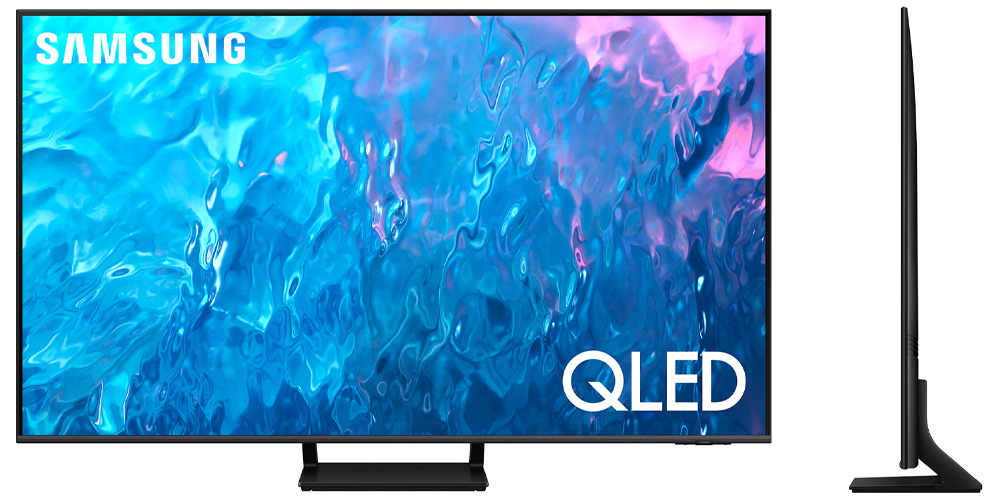
Type : Flat
The Samsung Q70C is going to be a very important model this year as it is the most affordable TV in Samsung’s lineup that still supports high framerate gaming. And thus can be an excellent low cost gaming TV.
Due to the lower cost the TV also loses the FALD backlight and has to settle with the less capable Edge LED system.
You can read our full analysis of this TV in our dedicated Samsung Q70C review.
Specifications
- 4K resolution (3,840 x 2,160)
- QLED display technology
- VA panel with 100/120Hz frequency
- Edge LED Backlight system (Dual LED)
- Quantum Processor 4K
- HDR10, HDR10+ Adaptive, HLG support
- OTS Lite / 2.0 channels 20W
- Game Bar 3.0, Filmmaker Mode, HGiG mode
- 4 x HDMI 2.1
- ARC / eARC, VRR, FreeSync, G-SYNC, ALLM, HFR
- WiFi5, Bluetooth 5.2
- Tizen Smart Platform 2023
- One Remote
Samsung Q60C (4K QLED TV)
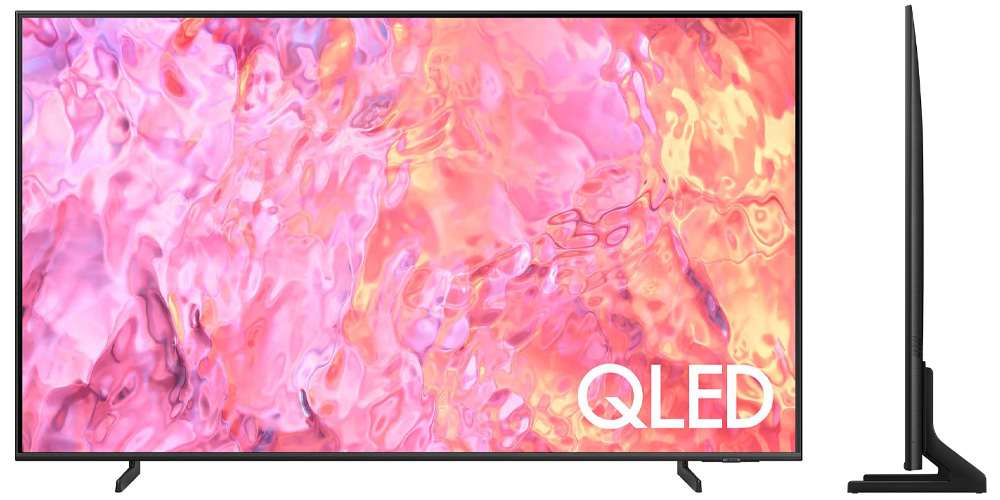
Type : Flat
The last of the QLEDs comes with certain reductions in specs all across the board. We find a less capable panel, a less capable processor and most importantly no HDMI 2.1 ports.
Full analysis and tests on this TV you can find in our dedicated Samsung Q60C review.
Specifications
- 4K resolution (3,840 x 2,160)
- QLED display technology
- VA panel with 50/60Hz frequency
- Edge LED Backlight system (Dual LED)
- Quantum Processor 4K Lite
- HDR10, HDR10+ Adaptive, HLG support
- OTS Lite / 2.0 channels 20W
- Game Bar 3.0, Filmmaker Mode, HGiG mode
- 3 x HDMI 2.0
- ARC / eARC, ALLM
- WiFi5, Bluetooth 5.2
- Tizen Smart Platform 2023
- One Remote
Samsung The Frame 2023 (4K QLED TV)
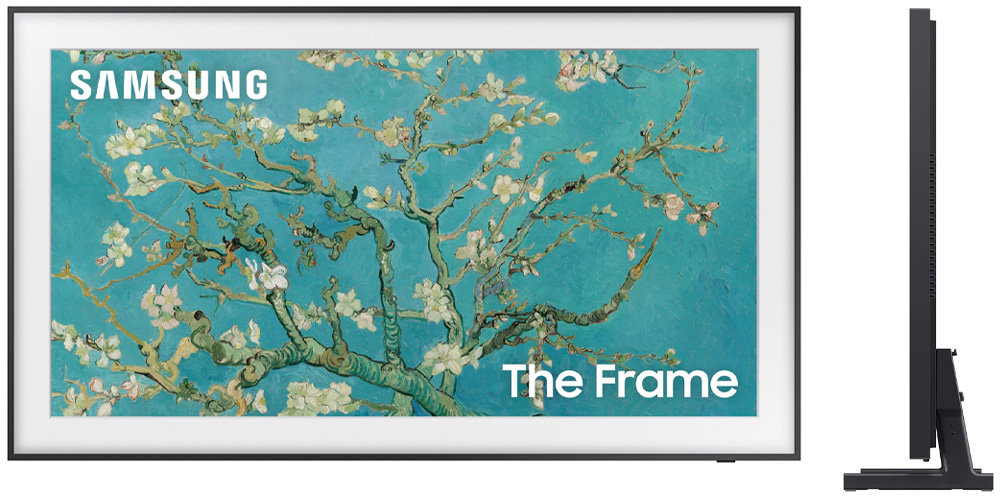
Type : Flat
Belonging in the LifeStyle series The Frame is basically a QLED in a more artistic dressing. Its specifications do look very close to those of the Samsung Q70C above with minor differences in the panels and audio systems.
And obviously the Frame has the ability to change frames with a wide variety available for you to choose from.
Specifications
- 4K resolution (3,840 x 2,160)
- QLED display technology
- VA panel with 100/120Hz frequency (32-50″ 50/60Hz)
- Edge LED Backlight system (Dual LED)
- Quantum Processor 4K
- HDR10, HDR10+ Adaptive, HLG support
- OTS (Lite in 43/50″) / 2.0.2 channels 40W
- Dolby Atmos support
- Game Bar 3.0, Filmmaker Mode, HGiG mode
- 4 x HDMI 2.1
- ARC / eARC, VRR, FreeSync, G-SYNC, ALLM, HFR
- WiFi5, Bluetooth 5.2
- Tizen Smart Platform 2023
- One Remote
- Matte LCD panel
- Interchangeable frames
Samsung CU8500 (Crystal UHD 4K TV)
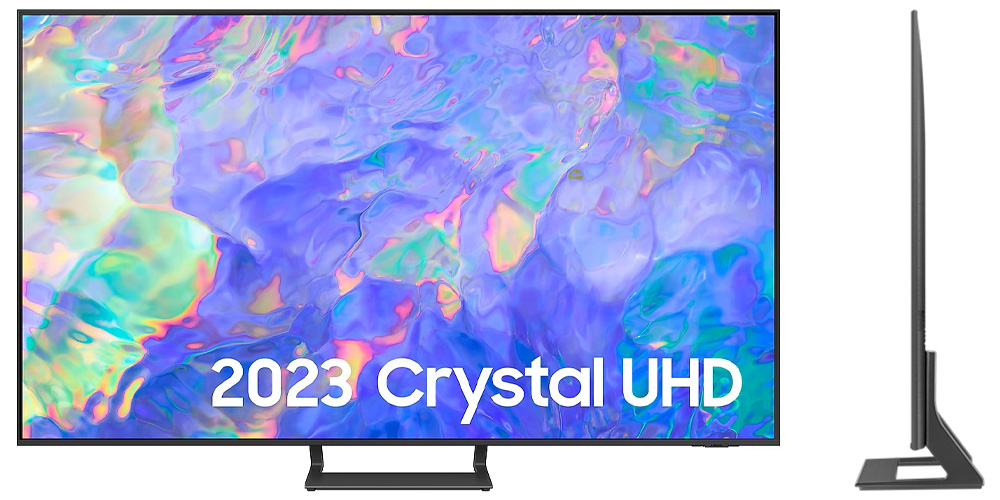
Type : Flat
The Samsung CU8500 is the top of the budget friendly Crystal UHD TVs. The Crystal series loses the Quantum Dot technology meaning it can display less colors on screen. We also get the less capable Crystal Processor 4K. Lastly the Tizen platform in the Crystal series do have some of its features reduced.
Specifications
- 4K resolution (3,840 x 2,160)
- VA panel with 50/60Hz frequency
- Edge LED Backlight system
- Crystal Processor 4K
- HDR10, HDR10+, HLG support
- OTS Lite / 2.0 channels 20W
- Filmmaker Mode, HGiG mode
- 3 x HDMI 2.0
- ARC / eARC, ALLM
- WiFi5, Bluetooth 5.2
- Tizen Smart Platform 2023
- One Remote
Samsung CU8000 (Crystal UHD 4K TV)
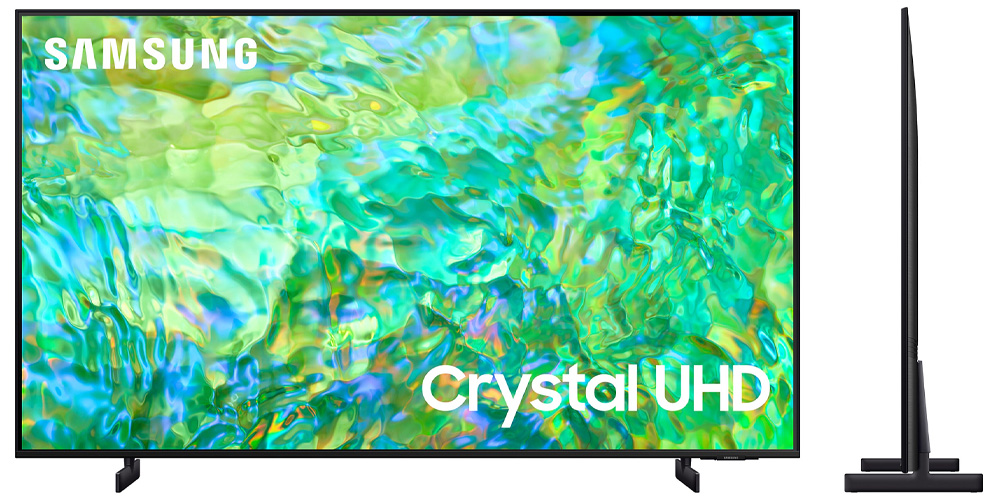
Type : Flat
The CU8000 may not be any different from the CU8500 in terms of specs but what is different is how these TVs perform. And this applies across all the Crystal TVs.
We have tested this TV and you can read all about it in our Samsung CU8000 review.
Specifications
- 4K resolution (3,840 x 2,160)
- VA panel with 50/60Hz frequency
- Edge LED Backlight system
- Crystal Processor 4K
- HDR10, HDR10+, HLG support
- OTS Lite / 2.0 channels 20W
- Filmmaker Mode, HGiG mode
- 3 x HDMI 2.0
- ARC / eARC, ALLM
- WiFi5, Bluetooth 5.2
- Tizen Smart Platform 2023
- One Remote
Samsung CU7000 (Crystal UHD 4K TV)

Type : Flat
The CU7000 may not be any different from the CU8000 in terms of specs but what is different is how these TVs perform. And this applies across all the Crystal TVs.
As a result the CU7000 is bound to have the least performance compared to all the above Crystal models.
You can check our testing of this model in our dedicated Samsung CU7000 review article.
Specifications
- 4K resolution (3,840 x 2,160)
- VA panel with 50/60Hz frequency
- Edge LED Backlight system
- Crystal Processor 4K
- HDR10, HDR10+, HLG support
- OTS Lite / 2.0 channels 20W
- Filmmaker Mode, HGiG mode
- 3 x HDMI 2.0
- ARC / eARC, ALLM
- WiFi5, Bluetooth 5.2
- Tizen Smart Platform 2023
- One Remote
This year’s lineup doesn’t seem to be really that interesting. As you said it feels like Samsung put a lot of attention on QD-OLED but little to anything else. A bit disappointing considering all prices went up. How they justify the price increase if they offer the same as 2022?
Hey Terry. Well, prices went up across the entire electronics industry so they do not really have to justify much. It is what it is and I think they believe that when people will see that prices are up across the board they will just have to live with it. But there are still good prices to be found. Certain brands like Hisense offer more competing prices with higher performance.
As a tech enthusiast, I’m excited to see Samsung expanding their QD-OLED series. It’s great to see new models and sizes being added to this relatively new technology.
I’m curious to know why Samsung is refusing to add Dolby Vision to their TVs. Is there a technical limitation or is it a business decision? It would be great to see this feature added in the future.
Hey there. No Dolby Vision in Samsung TVs is a business decision as Samsung doesn’t want to pay royalties to Dolby. In order for a TV to have Dolby Vision support it needs a dedicated chip and pay a royalty fee for each TV sold something that Samsung was against. That is why they went with HDR10+ instead which is very similar to Dolby Vision but not entirely the same.